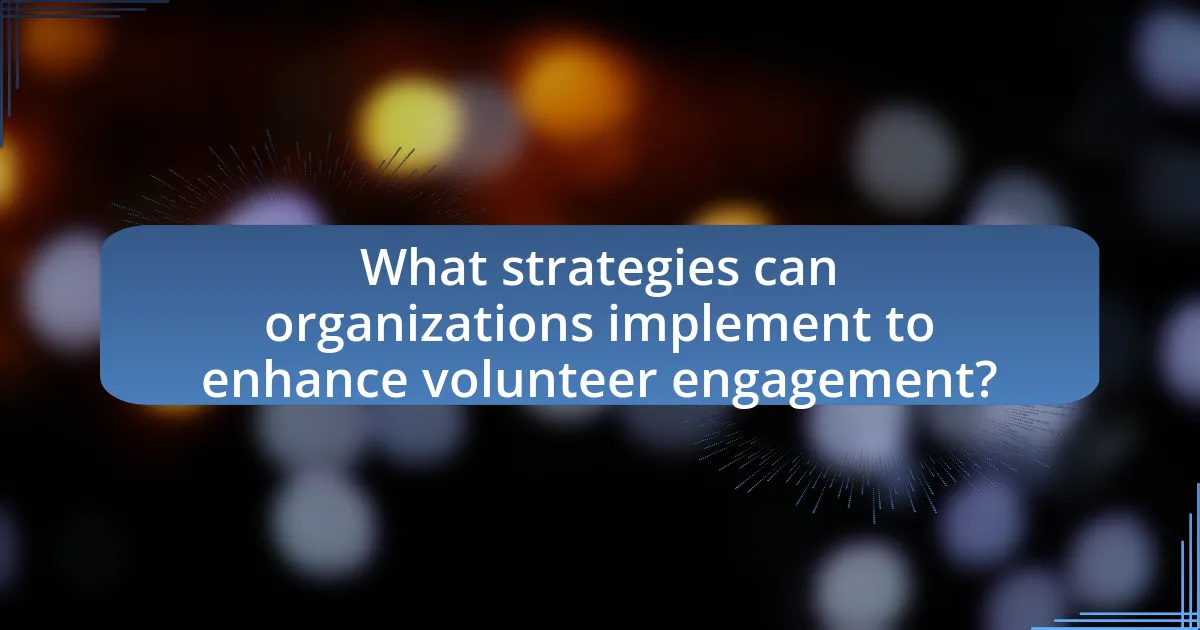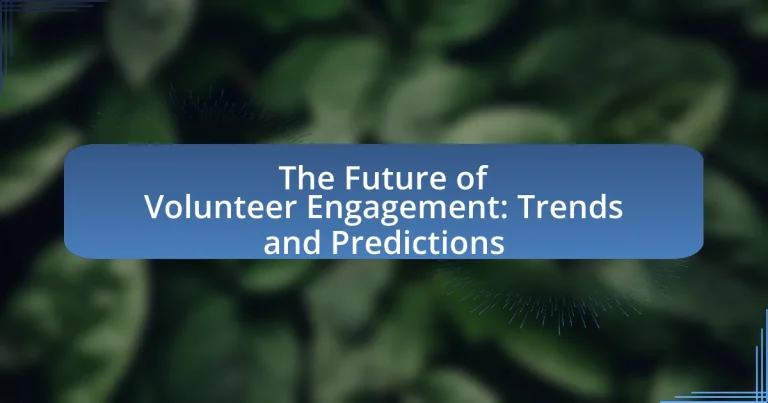The article focuses on the evolving landscape of volunteer engagement, highlighting current trends such as the rise of virtual volunteering, an emphasis on diversity and inclusion, and the integration of technology in volunteer management. It discusses how technology enhances communication and coordination, with emerging platforms like GivePulse and VolunteerMatch facilitating volunteer opportunities. The article also examines demographic shifts affecting volunteerism, the redefinition of volunteerism by younger generations, and the importance of creating meaningful experiences for volunteers. Additionally, it addresses challenges organizations face in recruiting and retaining volunteers, offering strategies to enhance engagement and adapt to changing expectations.

What are the current trends in volunteer engagement?
Current trends in volunteer engagement include the rise of virtual volunteering, increased focus on diversity and inclusion, and the integration of technology in volunteer management. Virtual volunteering has gained popularity, especially post-pandemic, allowing individuals to contribute remotely, which has expanded access and participation. Organizations are prioritizing diversity and inclusion to ensure that volunteer opportunities reflect the communities they serve, fostering a more equitable environment. Additionally, technology is being leveraged for efficient volunteer coordination, with platforms that streamline communication, scheduling, and tracking volunteer hours, enhancing the overall experience for both volunteers and organizations. These trends are supported by data indicating that 70% of volunteers prefer flexible opportunities, and organizations that embrace technology see a 30% increase in volunteer retention rates.
How is technology influencing volunteer engagement?
Technology is significantly enhancing volunteer engagement by providing platforms that facilitate communication, coordination, and recruitment. Digital tools such as social media, volunteer management software, and mobile applications allow organizations to reach a broader audience, streamline the onboarding process, and maintain ongoing communication with volunteers. For instance, a study by the Corporation for National and Community Service found that online platforms can increase volunteer participation by up to 50%, demonstrating the effectiveness of technology in mobilizing community support. Additionally, data analytics enables organizations to tailor their outreach efforts based on volunteer preferences and behaviors, further increasing engagement levels.
What digital platforms are emerging for volunteer coordination?
Emerging digital platforms for volunteer coordination include GivePulse, VolunteerMatch, and Mobilize. GivePulse offers a comprehensive platform that connects volunteers with organizations, allowing for easy event management and tracking of volunteer hours. VolunteerMatch serves as a bridge between volunteers and nonprofits, facilitating connections based on skills and interests. Mobilize focuses on community engagement, providing tools for organizations to recruit, manage, and communicate with volunteers effectively. These platforms are gaining traction due to their user-friendly interfaces and the increasing demand for streamlined volunteer management solutions.
How do social media trends impact volunteer recruitment?
Social media trends significantly enhance volunteer recruitment by increasing visibility and engagement among potential volunteers. Platforms like Facebook, Instagram, and Twitter allow organizations to share opportunities widely, reaching diverse audiences quickly. For instance, a study by the Corporation for National and Community Service found that 70% of volunteers reported learning about opportunities through social media. This demonstrates that social media not only broadens the reach of recruitment efforts but also fosters community engagement, making it easier for organizations to connect with individuals who are passionate about their causes.
What demographic shifts are affecting volunteer engagement?
Demographic shifts such as aging populations, increasing diversity, and changing workforce dynamics are significantly affecting volunteer engagement. For instance, as the population ages, organizations are seeing a rise in older volunteers who bring experience and time but may prefer different types of engagement compared to younger volunteers. Additionally, increasing diversity in communities is leading to a broader range of motivations and interests among volunteers, necessitating tailored approaches to engagement. Furthermore, the rise of remote work has altered traditional volunteering patterns, with more individuals seeking flexible opportunities that fit their schedules. These shifts highlight the need for organizations to adapt their strategies to effectively engage a diverse and evolving volunteer base.
How are younger generations redefining volunteerism?
Younger generations are redefining volunteerism by prioritizing flexibility, skill-based contributions, and social impact over traditional, time-bound volunteering. This shift is evident as millennials and Gen Z increasingly seek opportunities that align with their personal values and professional skills, allowing them to engage in meaningful ways that fit their lifestyles. For instance, a 2021 study by the Corporation for National and Community Service found that 70% of younger volunteers prefer short-term, project-based engagements rather than long-term commitments, reflecting their desire for immediate impact and adaptability.
What role does diversity and inclusion play in volunteer programs?
Diversity and inclusion are essential in volunteer programs as they enhance participation, broaden perspectives, and improve community impact. By incorporating individuals from various backgrounds, volunteer programs can address a wider range of community needs and foster innovative solutions. Research indicates that diverse teams are more effective, with studies showing that organizations with inclusive practices experience 2.3 times higher cash flow per employee and 1.7 times higher innovation. This evidence underscores the importance of diversity and inclusion in maximizing the effectiveness and reach of volunteer initiatives.

What predictions can be made about the future of volunteer engagement?
Predictions about the future of volunteer engagement indicate a significant increase in digital platforms facilitating volunteer opportunities. As technology continues to advance, organizations are likely to adopt more sophisticated online tools for recruitment, training, and management of volunteers. For instance, a report by the Corporation for National and Community Service highlights that online volunteering has grown by 50% over the past decade, suggesting a trend towards virtual engagement. Additionally, younger generations, particularly Millennials and Gen Z, are expected to prioritize meaningful experiences and social impact, driving organizations to create more flexible and purpose-driven volunteer roles. This shift is supported by research from the Deloitte Volunteerism Survey, which found that 70% of Millennials consider volunteering an important factor when choosing an employer. Thus, the future of volunteer engagement will likely be characterized by increased digital integration and a focus on meaningful, flexible opportunities.
How will volunteer engagement evolve in the next decade?
Volunteer engagement will increasingly leverage technology and data analytics over the next decade. As organizations adopt digital platforms for recruitment and management, they will enhance volunteer experiences through personalized communication and streamlined processes. For instance, a report by the Corporation for National and Community Service indicates that technology can improve volunteer retention rates by up to 50% when effectively utilized. Additionally, the rise of remote volunteering opportunities will broaden participation, allowing individuals to contribute from diverse locations, thus increasing overall engagement.
What new models of volunteerism are likely to emerge?
New models of volunteerism likely to emerge include virtual volunteering, micro-volunteering, and skills-based volunteering. Virtual volunteering allows individuals to contribute remotely, leveraging technology to connect with organizations and causes from anywhere, which has gained traction due to the COVID-19 pandemic. Micro-volunteering offers short, flexible tasks that can be completed in a brief time frame, appealing to those with limited availability. Skills-based volunteering focuses on utilizing specific professional skills to address community needs, enhancing the impact of volunteer efforts. These models reflect changing societal dynamics and the increasing demand for flexible, impactful engagement in volunteerism.
How will organizations adapt to changing volunteer expectations?
Organizations will adapt to changing volunteer expectations by implementing flexible engagement models and enhancing communication strategies. As volunteers increasingly seek meaningful experiences and personalized involvement, organizations will prioritize tailored opportunities that align with individual interests and skills. Research indicates that 70% of volunteers prefer roles that allow them to utilize their professional skills, highlighting the need for organizations to create specialized volunteer positions. Additionally, organizations will leverage technology to facilitate remote volunteering and provide real-time feedback, ensuring that volunteers feel valued and connected. This approach not only meets evolving expectations but also fosters long-term commitment and satisfaction among volunteers.
What impact will global events have on volunteer engagement?
Global events significantly influence volunteer engagement by altering the availability of volunteers and shifting the focus of their efforts. For instance, during crises such as natural disasters or pandemics, there is often a surge in volunteerism as individuals seek to contribute to relief efforts. According to a 2020 report by the Corporation for National and Community Service, volunteer rates increased during the COVID-19 pandemic, with many people stepping up to assist their communities. Conversely, global events can also lead to decreased volunteer engagement due to safety concerns or logistical challenges, as seen during the early months of the pandemic when many organizations paused in-person activities. Thus, the impact of global events on volunteer engagement is dynamic, reflecting both increased motivation to help and potential barriers to participation.
How can organizations prepare for future crises affecting volunteerism?
Organizations can prepare for future crises affecting volunteerism by developing flexible volunteer management strategies that can adapt to changing circumstances. This includes creating a robust communication plan to keep volunteers informed and engaged during crises, as evidenced by the increased reliance on digital platforms during the COVID-19 pandemic, which saw a 47% rise in virtual volunteering opportunities. Additionally, organizations should establish partnerships with local agencies to facilitate resource sharing and support, ensuring a coordinated response during emergencies. Training volunteers in crisis response and resilience can also enhance their ability to adapt and contribute effectively when challenges arise.
What lessons can be learned from recent global challenges?
Recent global challenges highlight the importance of adaptability and collaboration in volunteer engagement. For instance, the COVID-19 pandemic demonstrated that organizations must quickly pivot their strategies to meet emerging needs, as seen with the rapid shift to virtual volunteering opportunities. Additionally, the increased reliance on technology for communication and coordination has shown that digital platforms can enhance volunteer participation and outreach. Data from the 2021 Global Trends in Giving Report indicates that 54% of donors prefer to give online, emphasizing the need for organizations to embrace digital tools. These lessons underscore the necessity for flexibility and innovation in future volunteer engagement strategies.

What strategies can organizations implement to enhance volunteer engagement?
Organizations can enhance volunteer engagement by implementing strategies such as providing meaningful training, recognizing volunteer contributions, and fostering a sense of community. Meaningful training equips volunteers with the necessary skills and knowledge, which increases their confidence and effectiveness. Recognition of contributions, whether through awards or public acknowledgment, boosts morale and encourages continued participation. Additionally, fostering a sense of community through team-building activities and social events creates strong bonds among volunteers, leading to higher retention rates. Research indicates that organizations with structured recognition programs see a 30% increase in volunteer retention, demonstrating the effectiveness of these strategies.
How can organizations leverage technology for better engagement?
Organizations can leverage technology for better engagement by utilizing digital platforms and tools that facilitate communication, collaboration, and feedback. For instance, organizations can implement mobile apps and social media channels to connect with volunteers in real-time, enhancing their ability to share information and updates. Research indicates that 70% of volunteers prefer to engage through digital means, highlighting the importance of technology in meeting their preferences. Additionally, organizations can use data analytics to track volunteer participation and satisfaction, allowing for tailored engagement strategies that resonate with individual volunteers. This data-driven approach not only improves engagement but also fosters a sense of community among volunteers, ultimately leading to higher retention rates.
What tools can improve communication with volunteers?
Effective tools that can improve communication with volunteers include messaging platforms, project management software, and social media channels. Messaging platforms like Slack or WhatsApp facilitate real-time communication, allowing volunteers to quickly share updates and ask questions. Project management software such as Trello or Asana helps organize tasks and deadlines, ensuring that volunteers are informed about their responsibilities and progress. Social media channels, including Facebook Groups or Instagram, can foster community engagement and provide a space for volunteers to connect and share experiences. These tools enhance collaboration, streamline information sharing, and ultimately lead to a more engaged volunteer base.
How can data analytics enhance volunteer management?
Data analytics can enhance volunteer management by providing insights into volunteer engagement, performance, and retention. By analyzing data such as volunteer hours, demographics, and feedback, organizations can identify trends and patterns that inform recruitment strategies and improve volunteer experiences. For instance, a study by the Corporation for National and Community Service found that organizations using data analytics to track volunteer activities saw a 20% increase in volunteer retention rates. This demonstrates that leveraging data analytics not only optimizes resource allocation but also fosters a more engaged and committed volunteer base.
What best practices should organizations follow for effective volunteer programs?
Organizations should implement clear communication, structured training, and recognition systems as best practices for effective volunteer programs. Clear communication ensures that volunteers understand their roles and expectations, which enhances engagement and satisfaction. Structured training equips volunteers with the necessary skills and knowledge, leading to improved performance and retention rates. Recognition systems, such as awards or public acknowledgment, motivate volunteers and foster a sense of belonging, which is crucial for long-term commitment. Research indicates that organizations with robust volunteer management practices experience a 50% higher retention rate among volunteers, demonstrating the effectiveness of these best practices.
How can organizations create meaningful volunteer experiences?
Organizations can create meaningful volunteer experiences by aligning volunteer roles with individual skills and interests. This approach enhances engagement and satisfaction, as volunteers are more likely to feel valued and motivated when their contributions match their passions. Research indicates that organizations that provide tailored volunteer opportunities report higher retention rates and increased volunteer satisfaction. For instance, a study by the Corporation for National and Community Service found that volunteers who engage in activities that resonate with their personal interests are 50% more likely to continue volunteering. Additionally, organizations should foster a sense of community among volunteers through team-building activities and recognition programs, which further solidifies their commitment and enhances the overall experience.
What methods can be used to recognize and retain volunteers?
To recognize and retain volunteers, organizations can implement methods such as personalized appreciation, regular feedback, and opportunities for skill development. Personalized appreciation, such as thank-you notes or recognition events, fosters a sense of belonging and value among volunteers. Regular feedback helps volunteers understand their impact and areas for improvement, enhancing their engagement. Opportunities for skill development, including training sessions or leadership roles, not only improve volunteer capabilities but also increase their commitment to the organization. Research indicates that organizations that actively recognize and invest in their volunteers see higher retention rates, with studies showing that effective recognition can lead to a 50% increase in volunteer retention.
What are the common challenges in volunteer engagement and how can they be addressed?
Common challenges in volunteer engagement include lack of communication, insufficient training, and volunteer burnout. Addressing these issues requires implementing structured communication channels, providing comprehensive training programs, and promoting a healthy work-life balance. Research indicates that organizations with clear communication strategies see a 25% increase in volunteer retention rates. Additionally, offering ongoing support and recognition can mitigate burnout, as studies show that volunteers who feel appreciated are 50% more likely to continue their involvement.
What barriers do organizations face in recruiting volunteers?
Organizations face several barriers in recruiting volunteers, including lack of awareness, time constraints, and insufficient resources. Many potential volunteers are unaware of available opportunities, which limits recruitment efforts. Additionally, individuals often have busy schedules that prevent them from committing time to volunteer activities. Research indicates that 70% of people cite time as a significant barrier to volunteering. Furthermore, organizations may struggle with inadequate funding and staffing, which can hinder their ability to effectively promote volunteer opportunities and manage volunteers once recruited. These factors collectively create challenges in attracting and retaining volunteers.
How can organizations overcome volunteer burnout?
Organizations can overcome volunteer burnout by implementing structured support systems and fostering a positive volunteer culture. Providing regular training and resources helps volunteers feel equipped and valued, reducing feelings of overwhelm. Additionally, organizations should encourage open communication, allowing volunteers to express concerns and suggest improvements, which can enhance their engagement and satisfaction. Research indicates that organizations with strong support networks experience lower volunteer turnover rates, as volunteers are more likely to remain committed when they feel supported and appreciated.


